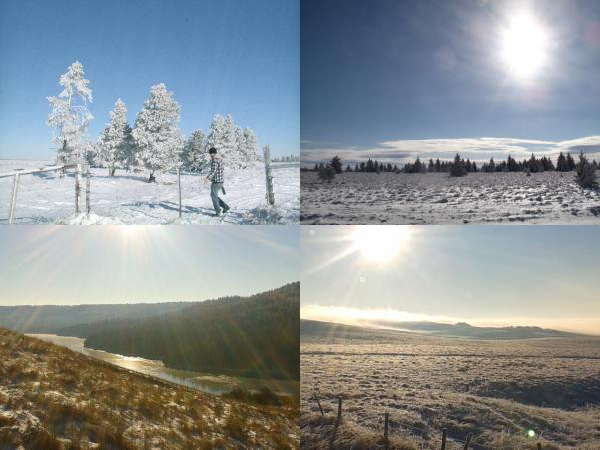Field Work : A walk in the Park.
By: Brad Van Paridon | April 3 2014
This blog post was originally posted on a University of Calgary Helminths Blog page that is currently being revamped and moved so please check back here or with me on twitter,
@bvanparidon for more information about this great graduate student blogging project. It also appeared on Science Borealis a
Canadian science blogging community, check them out and here is my piece about field work titled Field Work: A walk in the park.
One of the great things about working with parasites and especially those using wildlife hosts is the chance to leave the lab and do some field work. For me, a PhD student working at
both the University of Lethbridge and Calgary, this means a trip to the Cypress Hills Interprovincial Park in southeastern Alberta. This park spans the border between Alberta and
Saskatchewan and is somewhat of an anomaly as it is an island of sorts in the middle of the vast prairie landscape of the Canadian west. Cypress Hills is an area that was not covered and
flattened by the glaciers of the last ice age, resulting in hills that rise 1400 meters above the prairies. This creates an island ecosystem protruding from the seas of wheat and suitable
habitat for many species of animals. The park boasts a large population of elk and deer, which in turn feeds a healthy population of roughly 30 cougars. It also houses many species of
birds and is a welcome stopover in the migratory routes of many bird species each year. Arguably the most interesting inhabitant to the park however is the liver fluke (Trematoda)
Dicrocoelium dendriticum.
This small fluke is believed to have been introduced to North America and subsequently Cypress Hills from Europe where it is reported to be endemic. The incredible thing about this
parasite though is the life cycle. Dicrocoelium has a complex life cycle involving three hosts. Adults living in the livers of final hosts produce eggs that end up in the hosts feces
where they are ingested by a terrestrial snail. In the snail the parasite develops, grows and divides into many individual cercaria (tiny, fork-tailed trematode life cycle stage produced
through asexual division) and are coughed out of the snail in a mucous encased "slime ball" (it is actually referred to as a slim ball in some of the literature). Now this is where it gets
truly interesting. Ants will come along and presumably bring this slime ball back to the nest where they all chow down on it. Once inside the ant the majority of the parasites move to the
abdomen and encyst there as meteceracia (the stage infective to the final hosts) where they wait to get passed on to the final host. The final host in this case is any number of grazing
ruminants and in the park specifically it can be deer, elk or domestic cattle that are grazed there. So how do trematodes in ants get into the livers elk? Remember how I just said that
the majority of parasites in an ant go to the abdomen? The minority, in this case one, makes its way to the bundle of nerves in the ants head that constitutes the ant brain. Here it sets
up shop by wrapping around the nerve bundle. Ants infected with Dicrocoelium all have a parasite in the brain and all begin to act shall we say, clingy but not towards other ants they may have a crush on but rather towards plants.
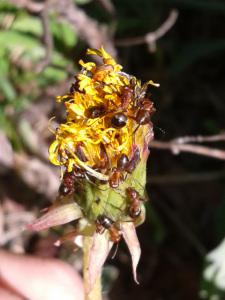

During parts of the day that are cool and won't dry out an ant sitting in the open the infected ants climb up plants and lock onto leaves and
flowers with their jaws. Here they remain waiting to be accidentally ingested by a grazing animal so they can get to the oh so tasty liver. This is an amazing example of host manipulation
by a parasite and yes, this guy exists in Alberta less than an hour south of Medicine Hat.
Naturally someone needs to be investigating this oddball and that means someone has to get out there and collect samples of this thing from the park. Naturally that sounds like a pretty sweet time so
I took up the cause and have been working on this system since 2011, which brings me back to the joys of field work. My latest trip to the park was November 2013 and the goal was to collect fresh
livers and adult parasites from elk that are killed in the annual elk management hunt. We do so with lots of help from the Alberta Parks Staff, Conservation Officers and of course the hunters
themselves. Basically any time an animal is shot in the park it needs to be called in to the CO's who come out an verify the tag. We just tag along, show up at the kill and get a fresh liver.
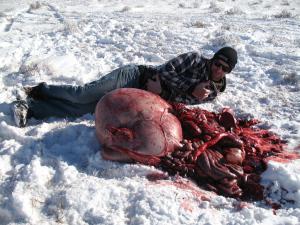
Myself next to the gut pile from a recently deceased elk, and you thought they smelt bad on the outside. (Brad van Paridon)
I have been touting the joys of field work this whole post and we always have a great time. How could we not with scenery such as this to enjoy.
However, during one foray out into the park to find some hunters that had just called in a kill, things became slightly less pleasant. As is normal in the park a thick fog descended onto
the flat prairie like plateau of the hills. The three photos above that look as though they could have been snapped on the prairies are actually the plateau of the hills and are at an
elevation of 1400 m where fog and clouds come and go quickly. Blanketed in fog it looks something like this.
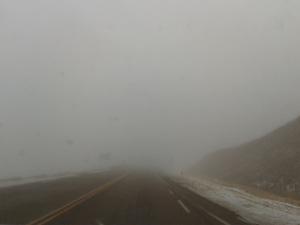
Fog Covered Hills (Brad Van Paridon)
Aside from the obvious driving hazards associated with travelling in thick fog, we must remember that hunting is also going on in these areas and although it is technically illegal to shoot
into fog, poor decisions are made on a daily basis. So this is where we found ourselves. Outside the truck, standing in the middle of a field, surrounded by fog so thick we can't see more
than a few meters in any direction and trying in vain to locate the hunting party that has just taken down an elk. Just then we got in touch with the hunters via cell phone and things were
looking up. We concluded we were in the right area but then the man on the other end of the phone stops and says" I gotta go they're (meaning the elk herd) are coming back around and we are
going to take another shot" and then he hangs up. Well, we quickly put it together that this was for sure time to leave the area as we might get caught in the middle of a live fire exercise.
Needless to say we made a quick exit and upon returning to the area in an hour so found three kills about 100 m apart and no more than 200 m from where we were originally standing. One of
these kills too had not been claimed and was being investigated by the officers present, a situation that might occur if someone did not know they had killed multiple animals until the fog
lifted. Hmmmm, makes you think.
Now, I don't think we ever really came close to being shot, I never heard gunfire while out in that field, but it did make me think that field work really isn't just a walk in the park.
It also made me reflect on other situations I got myself into in the name of field work. One time while searching for infected ants I disturbed a wasp nest and was stung more than seven
times on may face, chest and neck while running away. I have exposed myself to swimmers itch while collecting aquatic snails, thankfully never got it though. There was the time I stumbled
across what appeared to be an ideal cougar den complete with bones from the last meal. This time I was thankful that no one was home. But these things could happen to anyone who frequents
the outdoors right? That is what I told myself as walked through the pitch black of the Cypress Hills night, alone, carrying bags of liver sections, that would surely entice one of the many
cougars in the park, over to the cougar garbage bins. On second thought maybe I am bringing some of this on myself.
Brad Van Paridon
Rather read on a tablet? read as a PDF.
ZombieAnts - Episode 1
by: Brad Van Paridon | March 30 2014
Welcome to zombiants.ca, a science blog all about mind altering parasites. Imagine waking up one day, perhaps a day after you tried a new meal for this time and you realize that something
doesn’t feel right. Then imagine being taken over by an unknown force and compelled to climb to the highest point you can and wait. After waiting, frozen on your roof for example, for up
to hours, you feel the late morning sun rays hitting your face and as they do the unknown force slowly starts to weaken. As you start to heat up the force weakens until it eventually fades
away, you shake the cobwebs out and get on with your day. Unfortunately you’ve been infected with a zombie parasite. This story has been acted out in many science fiction films but you may
not realize how often these scripts are actually playing out on this planet all the time.
Parasite induced altered behaviour has long been recognized in multiple parasite/host interactions involving species of parasites ranging from unicellular parasites, fungi to small worms
called flukes. These relationships are most common in insect hosts but also occur in snails and potentially mammals as well. The intensity of the behavioural alteration ranges as well from
a simple mechanical interaction to full blown mind control. The inspiration for this site and the example scenario depicted above comes from a fluke/insect interaction involving common wood
ants and the liver fluke Dicrocoelium dendriticum.
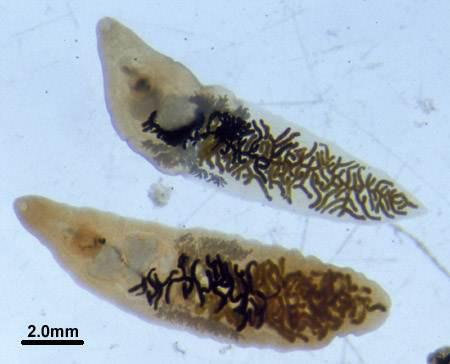
Adult liver flukes, Dicrocoelium Dendriticum
This story, like so many parasite stories, begins at the end. Eggs of adult flukes, living in the liver of grazing animals such as, sheep, goats, cattle, elk, deer, seemingly anything that
eats plants are passed out with the feces. Once out into the world the eggs are feasted upon by snails cruising the poop. The parasite multiplies in the snail until the snail has to cough
them out in a ball of mucus. Down and out on the ground once again the parasites wait for ants to come along, scoop them up and feed them to the rest of the nest. Once in the ant the
parasites move to the back of the ant and form a resting stage. They form cysts around themselves and wait. There is one parasite however that makes its way to the front of the ant and
wraps itself around a group of nerves in the ants head. These ants then show up every morning and evening, when the air is cool, on plants, clamping down with their mandibles, waiting,
still alive but unable to let go. It is here while they’re clinging on to the plants that grazing mammals such as a sheep, goat, deer, elk, cattle, depending on the county even camels
accidentally eat the ants. Even more strangely the ants will let go when the temperature rises and return when it cools, day after day until they are accidentally eaten. The cycle is now
complete and the parasites that where in the resting stage emerge and make their way to the liver where they grow into adults, mate and produce eggs.

Dicrocoelium life cycle
As an adult this parasite only grows to about 2cm but a single animal can have hundreds in its liver. This can lead to some serious complications for the animals but like most parasite
systems the hosts evolve resistance and immunity while the parasite evolves to outsmart host defences. This and many more features of parasite lifestyle will make up the content of this
blog, this and of course the mind controlling aspect of the life cycle. We aim to update you on this research as well as discuss many others of the mind controlling parasites, parasitism
and biology in general. Stay tuned for more and please interact with the site and me personally, @bvanparidon, on twitter.
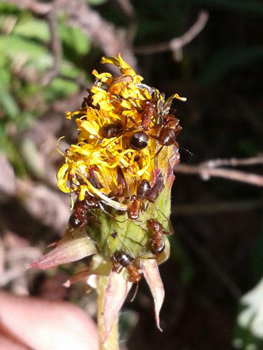
Infected ants clinging to a dandelion
Brad Van Paridon
Rather read on a tablet? read as a PDF.




